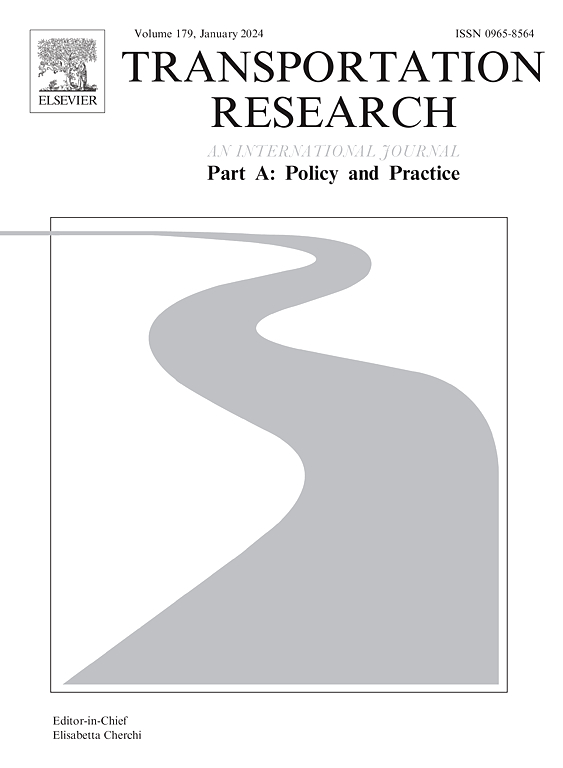A strategic variable fee for business-to-consumer carriers: A case study in Barcelona
IF 6.3
1区 工程技术
Q1 ECONOMICS
Transportation Research Part A-Policy and Practice
Pub Date : 2024-09-24
DOI:10.1016/j.tra.2024.104233
引用次数: 0
Abstract
Directive 2022/362 of the European Parliament and the Council offers fundamental guidelines that enable public administrations to implement road user charges, thereby internalizing the environmental costs associated with road transport. This directive also grants Member States a degree of flexibility to pursue their distinct strategies, making the analysis of various measures and their impact interesting for both cities and other stakeholders. Thus, this paper proposes a variable charge per hour for each stop made in the loading and unloading (L/U) zones by vehicles involved in direct delivery of products from businesses to consumers (B2C). The aim is to mitigate congestion and pollution during peak hours while reducing the movement of freight vehicles within the inner city. This charge functions as an economic policy tool to redirect inefficient B2C distribution towards sustainable distribution models, precisely in line with cities’ objectives. The proposed variable charge is evaluated for the cities of London, Milan, Stockholm, and New York, and compared with their current (or planned) pricing schemes. Additionally, a comprehensive analysis of the variable charge’s application in the case of Barcelona is conducted. This analysis encompasses considerations not only related to urban congestion, transport, and environmental costs (CO2, NOx, and PM2.5 emissions), but also the financial implications for the stakeholders involved in this activity. The results of the charge implementation indicate that the measure presented in this paper can reduce transportation costs, alleviate congestion, and lower CO2 emissions.
企业对消费者运营商的战略性可变费用:巴塞罗那案例研究
欧洲议会和理事会第 2022/362 号指令提供了基本准则,使公共管理部门能够实施道路使用费,从而将与道路运输相关的环境成本内部化。该指令还赋予各成员国一定程度的灵活性,使其能够实施各自不同的战略,从而使城市和其他利益相关者能够对各种措施及其影响进行分析。因此,本文建议对从企业直接向消费者运送产品(B2C)的车辆在装卸区(L/U)的每次停靠收取每小时不等的费用。其目的是缓解高峰时段的拥堵和污染,同时减少货运车辆在内城的行驶。该收费作为一种经济政策工具,可将低效的 B2C 配送导向可持续的配送模式,这与城市的目标不谋而合。我们对伦敦、米兰、斯德哥尔摩和纽约等城市的拟议可变收费进行了评估,并将其与这些城市当前(或计划中)的定价方案进行了比较。此外,还对可变收费在巴塞罗那的应用进行了全面分析。该分析不仅考虑了城市拥堵、交通和环境成本(二氧化碳、氮氧化物和 PM2.5 排放),还考虑了该活动对利益相关者的财务影响。收费实施的结果表明,本文提出的措施可以降低运输成本、缓解交通拥堵并减少二氧化碳排放。
本文章由计算机程序翻译,如有差异,请以英文原文为准。
求助全文
约1分钟内获得全文
求助全文
来源期刊
CiteScore
13.20
自引率
7.80%
发文量
257
审稿时长
9.8 months
期刊介绍:
Transportation Research: Part A contains papers of general interest in all passenger and freight transportation modes: policy analysis, formulation and evaluation; planning; interaction with the political, socioeconomic and physical environment; design, management and evaluation of transportation systems. Topics are approached from any discipline or perspective: economics, engineering, sociology, psychology, etc. Case studies, survey and expository papers are included, as are articles which contribute to unification of the field, or to an understanding of the comparative aspects of different systems. Papers which assess the scope for technological innovation within a social or political framework are also published. The journal is international, and places equal emphasis on the problems of industrialized and non-industrialized regions.
Part A''s aims and scope are complementary to Transportation Research Part B: Methodological, Part C: Emerging Technologies and Part D: Transport and Environment. Part E: Logistics and Transportation Review. Part F: Traffic Psychology and Behaviour. The complete set forms the most cohesive and comprehensive reference of current research in transportation science.

 求助内容:
求助内容: 应助结果提醒方式:
应助结果提醒方式:


